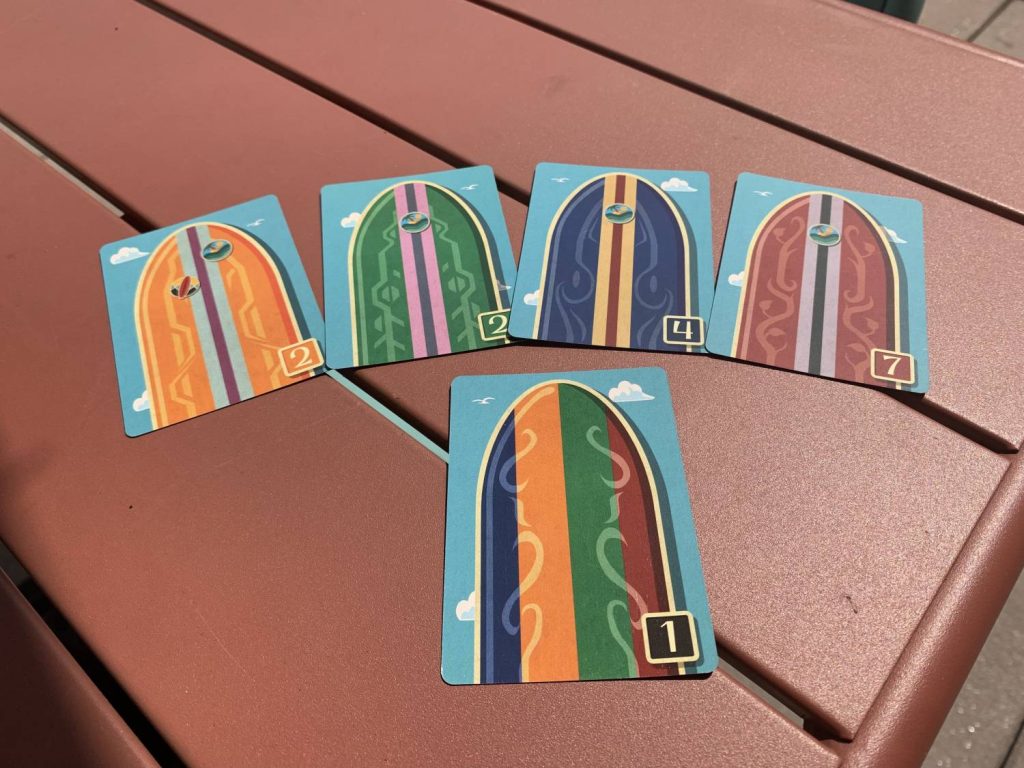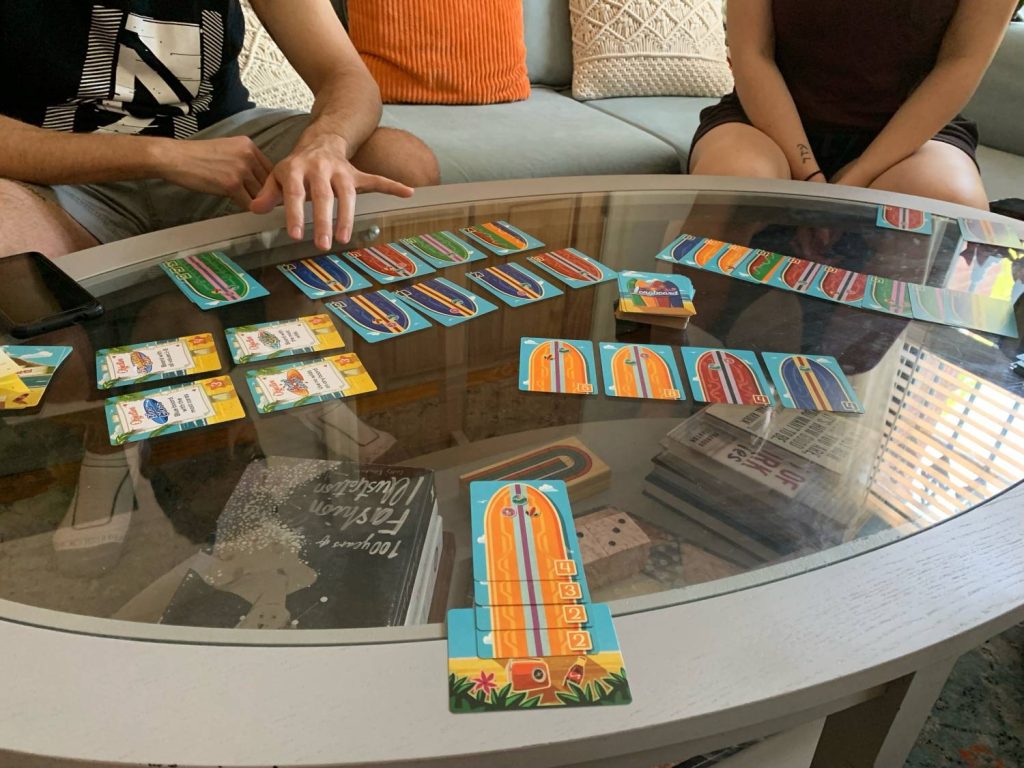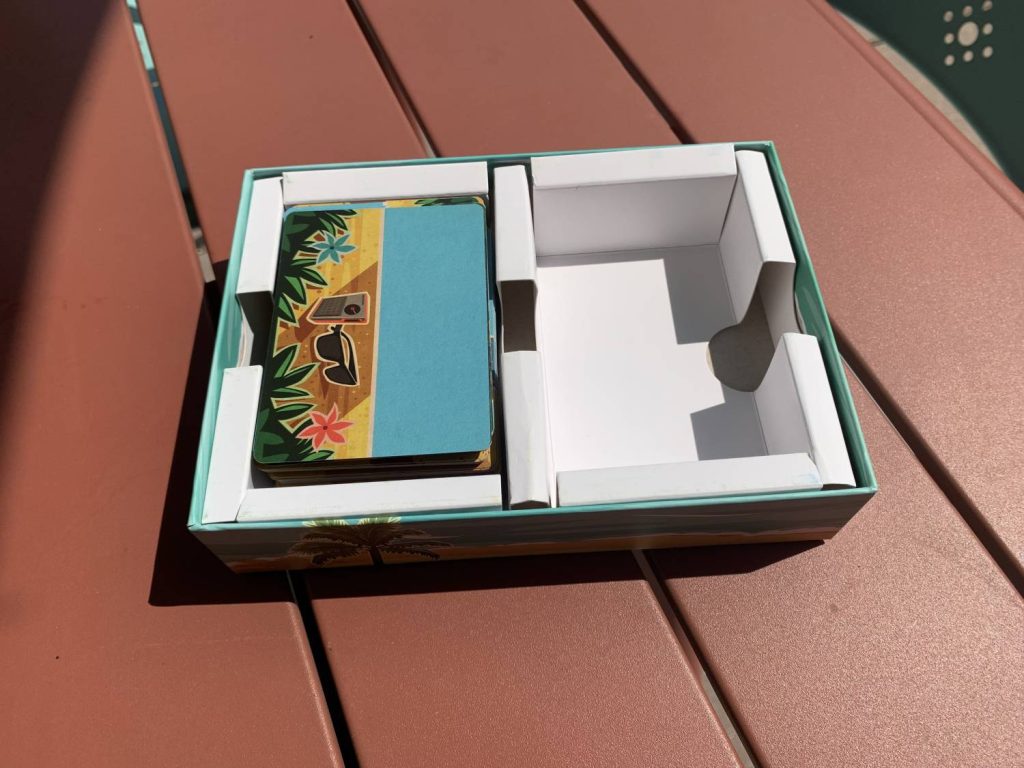Disclosure: Meeple Mountain received a free copy of this product in exchange for an honest, unbiased review. This review is not intended to be an endorsement.
Every time I get my hands on a new Reiner Knizia game, I find myself asking the same breathless question: Will this game be great? There’s a current (deserved) vogue for Knizia as a beloved designer, so I won’t go into this at length. Suffice it to say that with a track record like his, the question is warranted.
The latest Knizia title to be subject to my question is Longboard, published by 25th Century Games. It falls into Knizia’s capacious filler output, a 20-minute card game for 1-4 players in which you compete to make the “coolest and biggest longboards.”
Enough stalling. Is it great?
A Fresh Coat of Wax
 Each card shows the end of a longboard in one of four colors or, more rarely, all four colors. There’s a number in the lower right corner, and most boards have between one and three round stickers towards the top. Players start the game with two cards in their supply.
Each card shows the end of a longboard in one of four colors or, more rarely, all four colors. There’s a number in the lower right corner, and most boards have between one and three round stickers towards the top. Players start the game with two cards in their supply.
After that, reveal three random objective cards. These award bonus points at the end of the game for meeting certain conditions, such as longest board, longest board in a specific color, or most wild cards on a board. The objectives help guide your choices while playing. Their 3-4 point bonuses may not seem like much, but Longboard is often won by exactly such a margin.
 On your turn, you pick two actions from a pool of three (you can repeat). You can draw a card from the deck to add to your supply, you can build to either start a board or add to one you’ve already started, or you can swap.
On your turn, you pick two actions from a pool of three (you can repeat). You can draw a card from the deck to add to your supply, you can build to either start a board or add to one you’ve already started, or you can swap.
Drawing is what it sounds like: You take a card from the top of the deck and add it to your supply.
Building is reminiscent of Knizia’s Lost Cities. Each card you add has to be in the same color and has to either equal or exceed the value of the previous card.
Swapping? Oh, we’re gonna talk about swapping.

Swap Meet
Swapping is the heart of Longboard. “Swap” is generous, as it implies some amount of consent. Really what’s happening is you’re stealing another player’s card and leaving something to make up for it. I would hate this mechanism if it weren’t for the governing principle: whatever you give the other player in exchange for their card has to exceed—not equal—the value of the one card you are taking. If you want an eight, the highest value, you’ll have to give them at least two cards that total nine or more.
This creates a truly entertaining and permutational play space, where you are constantly prioritizing what cards to build and when based on what other players have and what they need. If someone is well-positioned to take your red 5 on their turn, maybe you skip straight from the red 1 you put down a few turns ago to that 5. Hard to say. How many 2’s and 3’s and 4’s are already out?
The other wrinkle that keeps the game from becoming a swap meet is that the player swapping has to immediately build with the card they take. You can’t take a high card from someone else to keep it for later, no no. If you take a card, it’s yours buddy, and you better be ready to use it.
“If it weren’t for swapping, this wouldn’t be an interesting game” is a dumb thought I just had. The game is built entirely around swapping. If it weren’t for the motor, cars would be useless. Thanks to the swap mechanism, you are always aware of what other players are doing. Every move is interesting as a result. Sometimes you draw just to have more arithmetical range for future swaps. Sometimes you’ll swap someone a card you know they won’t use just to take it back on your next turn.
It takes a couple of plays to really appreciate the modest depths, but like many of Knizia’s games, it grows on you.
I tried workshopping something with “Wipeout” and “Why pout?” but I don’t know yet.
I have one criticism and one concern. The criticism relates to the production. While 25th Century Games has done a characteristically thorough job with the aesthetics, Longboard is in a box that is twice as big as it needed to be. I have photographic evidence:

It’s a minor quibble when you’re already talking about a small box, but it could be even smaller.
As for my concern: In five plays, I haven’t come to a conclusion about how much of an impact skill has on the outcome of Longboard. My most recent game, which had the widest range of scores so far, was also the first where I intentionally played for Longboard’s end trigger (don’t worry about it). It may be that I’m just starting to get it. I didn’t think Lost Cities had any skill ceiling until I’d played it a ton.
That concern only applies to Longboard’s long term prospects. In the short term, the only term for which I can really speak at the moment, it has all the trademarks of a solid Knizia filler: rules that can be explained in a handful of minutes, a simple but clever mechanic that’s highlighted by an uncluttered design, timing considerations that only become more obvious as you explore the game further, and a wonderfully interactive game space.
Is it great? No, it’s not great. It’s somewhere between good and very good. With most designers, though, we wouldn’t start with the assumption that it might be great in the first place.












Add Comment